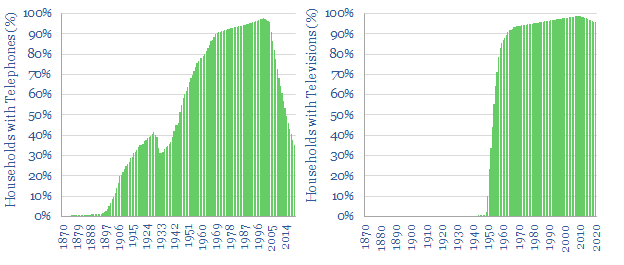This technology transition database plots the adoption rates for twenty technologies that transformed living standards around the United States, year-by-year, from 1870 to 2020. Adoption rates are more rapid for technologies when they require less infrastructure, are more transformational, are more economic and are more recent.
In this data-file, we chose twenty technology that reached widespread adoption in the United States over the past 150-years. For each technology, we quantified market adoption rates, using data sources such as US censuses that go back to the 19th century.
As an example of a slow technology transition in our database, Alexander Graham Bell invented the first example in 1876. They were installed in 2% of households by 1897, 10% by 1903, 50% by 1946 and 90% by 1970. The adoption rate was 1.2% of households per year as telephones expanded from 10% to 90% of the US population.

As an example of a medium-paced technology transition, electricity was first commercialised in 1882. It surpassed 2% share in 1896, 10% in 1909, 50% share in 1924 and 90% share in 1949. The adoption rate was 2% of households per year as electricity expanded from 10% to 90% of the population.

As an example of a fast-paced technology transition, TVs were first commercialised in 1928. But they only began to gain share in the late-1940s, reaching 2% of households in 1949, 10% in 1950, 50% in 1954 and 90% in 1962. The adoption rate was 7% of households per year as TVs expanded from 10% to 90% of the population.

20 examples in total are aggregated in the technology transition database. Covered technologies include electricity, gas heating, stoves, running water, flush toilets, automobiles, fridges, dishwashers, air conditioners, radio, wired cable, televisions, VCRs, microwaves, home computers, fixed-line telephones, cell-phones, internet access, broadband and social media.
All the data are aggregated in the ‘output’ tab to draw correlations and conclusions on what drives the pace of technology transitions. The data are discussed in depth in a research note here.
A general finding in our braoder energy transition research has been that new technologies take longer to reach maturity than might intuitively be expected (note here) and in our view, markets often over-value new technologies and under-value incumbents (note here).
